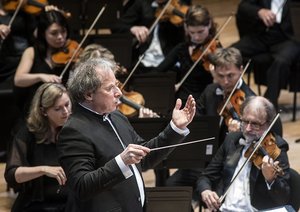
Budapest, March 27, 2019: Müpa: Ever since Budapest’s new concert hall—known as “Müpa” or “Palace of Arts”—with its combination of high-tech echo chambers and its traditional common-sense “shoebox” design opened in 2005, I’ve wanted to hear it in action. Located at the edge of downtown—alongside the Danube, right next to the comically hideous 2002 National Theater—it is not an imposing building from the outside, but welcoming and logically laid out on the inside. The main hall, the Bartók National Concert Hall, is a soft-curved wooden shoebox with a very sensible capacity of 1700. Its acoustic was overseen by Russell Johnson. The massive organ, built by the Pécs Organ Manufactory and Mühleisen Stuttgart, features an imposing prospect—including a battery of pipes protruding from the façade—and is one of the largest of its kind.
Along the walls above the upper tier—vaguely colored like a Scottish tartan—are the resonance boxes that can be closed or opened to give the desired length of reverb for the program at hand. Although closed on this occasion in late March, they are apparently in regular use—in contrast to fancy features like the Sala São Paulo’s adjustable ceiling, which is very cool in theory but hardly used in practice. Now: one visit to a concert hall cannot begin to give an adequate idea of its acoustic. But this one impression of hearing the Concerto Budapest, one of five symphony orchestras in Budapest, suggested that at its best, the acoustic is superb.
The Rambunctious Joy that is King Ubu’s Dinner Music
And what a concert it was. More specifically: What a first half! On the far side of intermission, a very finely played, generally soft-edged Rite of Spring awaited the listeners, full of well-shaped individual contributions, sexy contrabassoon notes, and fierce highlights. It didn’t have the ferocious bite I look for in the work, delivering—*de gustibus*—rather urbane suaveness instead. A bit like the Concertgebouw Orchestra might play that work. Indeed, like in Amsterdam, the perception may have been shaped by the acoustic which gave the impression of some orchestral energy dissipating upwards: even the greatest *fff* climaxes were not shrill or harsh or even particularly loud.
It would have been a more impressive performance, hadn’t that first half rocked as hard and delighted as much. Bernd Alois Zimmermann’s Musique pour les soupers du Roi Ubu—which incidentally throws out a quote from Le Sacre right off the bat on the organ—is a tumultuous, riotous, quintessential musical collage: None of the music is, *en détail*, original. But collectively the phrases as put together by Zimmermann, create a unique, decidedly original work.
It certainly sounds, in parts, like a “who’s that composer” guessing game. But more to the point, it is a riveting, compelling work all of its own which has, not in any individual incident but structurally, parallels in the music of Gustav Mahler and Charles Ives. And then there are four solo basses fiddling for their life up front in episodes that make Mahler’s “Frère Jacques” episode seem like child’s play. Perhaps most notably, instead of being doom-and-gloom as one would might reasonably expect from the composer of the *Ecclesiastical Action* (“I turned and beheld all the injustice perpetrated under the sun”), it is very often very funny. The classical bits (from plainchant to Stockhausen’s banging, repetitive chords of Klavierstück IX, and with plenty Wagner in the middle) are interrupted by Jazz-outbreaks that sound like someone turned the knob on the radio… eventually blending it with a medieval flute consort and then an ever-increasing amount of musical layers. E-guitars and basses are thrown into the mix, too. Altogether a bit like someone was taking Schnittke, Purcell, Monty Python and started juggling. What a joy!
Supple Pianism and a Lesson in Orchestral Alertness
The rest of the front-loaded first half of the concert consisted of the two piano-and-orchestra humdingers, the Rachmaninov Rhapsody on a Theme of Paganini and Lutosławski’s Variations on a Theme of Paganini. Andrei Korobeinikov played with rare feeling: short notes were still soft-edged. There was no incident of harsh banging, although banging is certainly required by at least Rachmaninov. What a *very* pleasant surprise in works where technical efficiency and accuracy, however necessary, would be so very much insufficient.
If that hadn’t been enough for enthusiasm, the Concerto Budapest—long established but revived and raised to new heights by its current music director András Keller (of Keller Quartet fame)—performed with absurd accuracy and sensitivity. The turn-on-a-dime-agile brass was secure; the strings warm and wispy-velvety in the true pianissimos; the woodwinds colorful. Moreover, the collective responded in such minute detail to Keller’s instructions that it just about took your breath away. Climaxes were approached not with a permanent swell but only quick peaks followed by an immediate and gentle receding of the strings. It’s just the way you think a string quartet player would want to make his orchestra play. You just don’t think he’d actually achieve it. Astonishing… just as it was impressive how the band could disappear into the background by becoming pure atmosphere—both in the pointillism of Lutosławski and the Delacroix-like tone painting of Rachmaninov. At one point I pinched myself: Is it really that good or am I hearing things?
After the concert an exhausted Keller said, with refreshingly level-headed pride: “They really are that good. And they play more than 40 programs – not concerts: programs! – a year. I think Concerto Budapest can claim to be the second best orchestra in Budapest [after Iván Fischer’s Budapest Festival Orchestra].” A second-best—assuming this concert was not a positive outlier—that would be the very best in most cities. I know I’ll keep my ears peeled for them.
